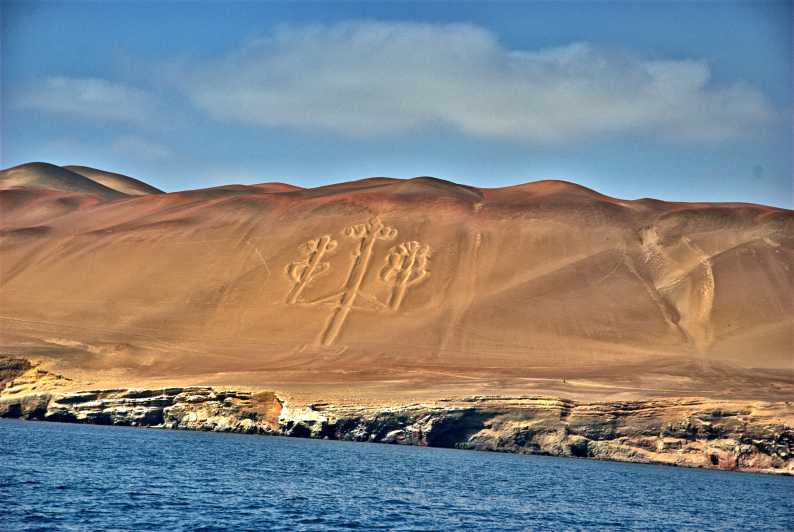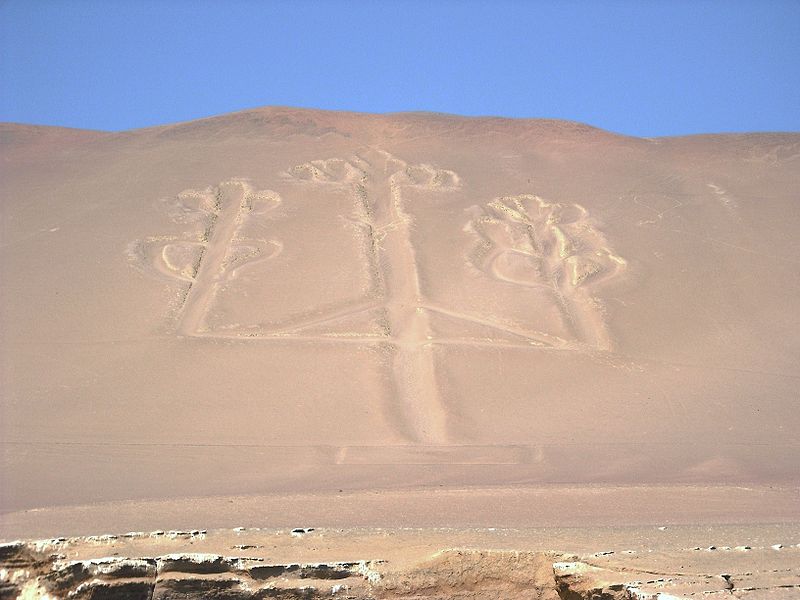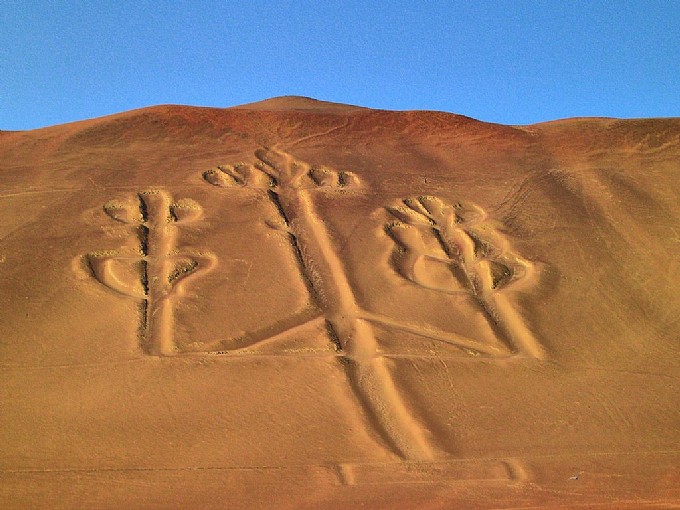The Paracas Candelabra

The Paracas Candelabra is a giant geoglyph engraved on the side of a mountainous hill in the Paracas Peninsula, which is a desert peninsula located within the Paracas National Reserve, a protected natural area in Peru, in the Ica region.
The accepted theory is that the engraving was created around 200 BCE because of some pottery found in the area near the Candelabra.
Such remains belonged to the enigmatic Paracas culture, famous for their elongated heads, therefore the Candelabra is attributed to them and known as the “Paracas Candelabra”.
On the other hand, there are many researchers convinced that the geoglyph could be much older and not created by the Paracas, who inhabited several areas that were already occupied before them.
The figure is more than 180 meters long in height and can be seen from the sea from a distance of 12 miles.

In order to carve it, its creators had to dig trenches at least 60 cm deep, finally placing rocks around the figure.
With no real culture to tie this geoglyph to, we can’t assume with certainty who made it and especially why, since the position itself is quite enigmatic.
It can only be seen from the sea or from above and would have had no use in ceremonial practices whatsoever.
Theories And Interpretations
Considering the enigmatic nature of the giant drawing, there are several theories about its creation.
The interpretation given by the conquistadores was that it indicated the Holy Trinity, while Peruvian writer Beltràn Garcìa thought it was a giant seismograph capable of registering seismic waves.
According to scholar Renè Guenon, the Candelabra would represent the Tree Of Life.
Modern archaeologists suggest it could represent Viracocha’s Lightning Rod, the most important pre-Columbian god that was often represented with his lightning rod, with great resemblance to the Hindu god Indra, the Greek god Zeus, and the Phoenician god Baal.

For these reasons, it has been speculated by several scholars that the Candelabra might’ve been drawn by either the Phoenicians or Indian civilizations.
Even though we have no evidence that these two cultures came to South America in the remote past, an interesting take by a team of Indian scholars actually ties the Candelabra to Hindu roots.
The Hindu Hypothesis
This theory suggests that the Candelabra may actually have been described in the sacred text “Ramayana” when the Vanaras are sent to the 4 corners of the world by king Surgiva.
If we analyze the text, we see that the references given to the Vanaras by the King are quite specific and real.
First, he gives them directions and tells them they would first end up on Java Island.
After circling a huge island with beautiful lakes, swans, and mountains, which should be New Zealand, they’d have to sail a really vast and calm yet frightening sea, which Hindu scholars suggest could be the Pacific Sea (which gets its name from its quiet nature).
Finally, they would see a “rock peak, etched on which is a golden pylon resembling a palm tree with three branches and a golden podium. That pylon of the palm tree is constructed as the easterly compass by celestial gods, and beyond that, a completely golden mountain is there, the Udaya Mountain, the Mt. Sunrise, beyond which it is all west”.
Although this interpretation is purely speculative, we’ve already seen that mythological Hindu accounts might hold true historical facts, like the recently discovered underwater city of Dwarka, which modern archaeologists considered to be just a myth.
To add to the theory, Paracas could be a distorted version of the Sanskrit word ‘Prakash‘ (प्रकाश्) which means light or brightness.
Another word could be ‘parakash‘ (पराकाश) which means ‘distant view‘, as this trident could have served as a guiding beacon for the Hindu Vimanas.
Despite the many speculations and hypotheses that have arisen around the candlestick, its true meaning and the reason why it was made still have no explanation.
